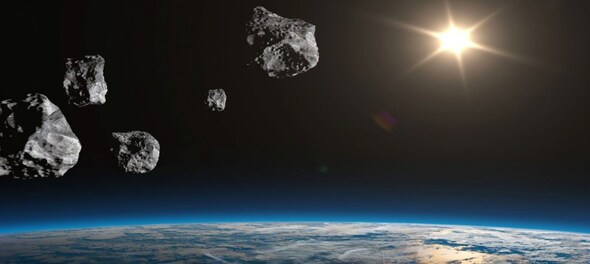
Two asteroids are heading towards Earth and expected to make their closest approach to the planet on Tuesday, August 29. Asteroid 2023 QK5 and 2023 QD2 are expected to pass close to Earth on Tuesday, according to NASA’s Jet Propulsion Laboratory.
Asteroid 2023 QK5 is on a trajectory that will bring it within a distance of just 1.5 million km from Earth, the National Aeronautics and Space Administration (NASA) said. It is moving at a speed of 24,548 km per hour, which is nearly comparable to the velocity of a space shuttle.
Asteroid 2023 QK5 falls within the Apollo group of Near-Earth Asteroids, which are characterised by their orbits that cross Earth's path, and semi-major axes larger than Earth's own orbit. Despite its notable speed and close proximity, the asteroid's modest diameter of about 37 feet has led to its exclusion from the classification of 'potentially hazardous objects.'
The classification threshold for potentially hazardous objects begins with asteroids larger than 492 feet in diameter.
On the other hand, Asteroid 2023 QD2 is a house-sized asteroid and it has a width of 46 feet. It belongs to the Aten family of asteroids.
Has an asteroid ever hit Earth?
From the gigantic impact crater in present-day South Africa, dating back two billion years, to the Chicxulub crater buried beneath Mexico's Yucatan peninsula, responsible for the extinction of dinosaurs 65 million years ago, asteroids have occasionally struck, leaving a lasting mark on our planet's geological landscape. While Asteroid 2023 QK5's size might not trigger alarms, history has shown that even smaller asteroids can have a significant impact when they collide with Earth's surface.
One of the most recent and memorable encounters with an asteroid occurred during the Chelyabinsk meteor event in Russia in 2013. This event drew global attention due to its unprecedented documentation through dashboard cameras in cars. The meteor, measuring around 20 metres in diameter, entered Earth's atmosphere at a speed of 19 km per second, ultimately disintegrating about 30 km above the surface. The resulting explosion released energy equivalent to 500 kilotons of TNT, causing damage to thousands of buildings and sending numerous individuals to local medical facilities.
What are asteroids?
Asteroids are the leftover pieces of rock from when the solar system and its planets were created about 4.6 billion years ago. These rocky bits go around the Sun in paths that are like flattened circles or stretched-out circles called ellipses. Sometimes, they spin and move in strange ways, tumbling and falling through space in a not-so-organised manner.



